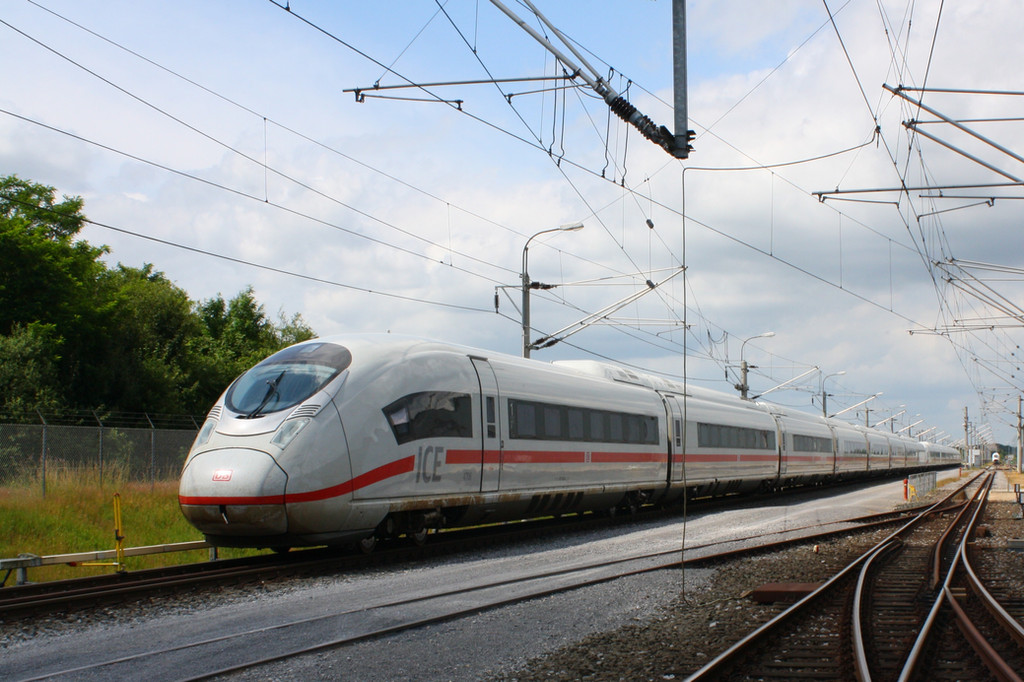HOME | DD
 ZCochrane — Class 407
by-sa
ZCochrane — Class 407
by-sa

Published: 2012-07-01 17:58:28 +0000 UTC; Views: 1324; Favourites: 18; Downloads: 90
Redirect to original
Description
There were a lot of Velaro D (class 407) high-speed EMUs in Wegberg. Like, all of them. I actually don't know this for certain, but of sixteen that were built so far, I counted at least nine and know where a further three could have been hiding easily. But as wide areas of the test center were gated off, I wasn't able to verify this information. Train 407 006 is one of (at least) three you can see in this picture alone. Sadly, none of the many trains were open to visitors, which I think is a real shame.DB's official marketing name for these units is not ICE 4 or anything, but "The new ICE 3", which is way too confusing for rail fans. Class 407 or Velaro D (Siemens's name; the older ICE 3s of class 403 and 406 are the predecessors of the Velaro family, not part of it) is preferred. Fifteen sets were ordered for cross-border traffic in Germany and France, in the future also Belgium and the Netherlands. A sixteenth was ordered to replace two partially damaged older ICE 3; the remaining cars of those two will be recombined into a new set.
You may have noticed that I did not include the UK and the Channel Tunnel in the list of countries where DB wants to use them. The reason is that even though DB has very publicly announced their intentions to this effect, they haven't actually ordered the necessary upgrade from Siemens yet. Still, they keep complaining that it is Siemens's fault that the service won't be able to start in 2013 as originally planned. On the other hand, it is Siemens (or specifically Siemens's supplier's) fault, too, because approval for France and Belgium is severely behind schedule. And approval for Germany, too. But at least one train is approved right now and the others will soon be. Sadly only in single, which makes them operationally useless, but full approval in single and double sets for all of Germany is bound to come by the end of the year, after which they will reinforce the (way-to-small) domestic fleet for a while.
Along with new crash worthiness standards, the train also got a new nose. I know no person that likes this nose better than the original. On the other hand, the new nose is supposed to close more reliably than the often-open end of the ICE 3.
By the way, if you're wondering about the cable hanging in the middle of the track, and the yellow handle at the third rail: This creates a ground connection, ensuring that the overhead and third rail lines are both without electricity. This was necessary because Siemens built a walkway over these tracks, as a basic aluminum bridge, which brought people closer to the overhead lines than would be safe otherwise. Of course, trains can't run while those things are in place, but that is kind of the idea anyway.
Related content
Comments: 9

I must be the only person who likes the new design, Nice shot!
👍: 0 ⏩: 1

I guess from this angle, it isn't really bad, but I do like the original more.
I think this design looks better in the Eurostar version, though.
👍: 0 ⏩: 1

What s with the weird vertical vire in the middle of the image? From this point of view it seems to be connected to the catenary in such way it would actually obstruct the pantograph.
And what the heck R the narrow gauge tracks doing on a high-speed line? Althogh they are rusted so they re not used much often.
👍: 0 ⏩: 1

That is an earthing wire. During the festival, people had to cross those tracks on a short bridge built over them (about a meter high), and to prevent any danger to the people, the electric lines on these tracks were shut off. To make sure that nobody else can turn them on again, and to prevent any other odd effects that happen at high voltages, it is necessary to earth the overhead lines - basically, connect them directly to the rails, so that you have a short circuit and the electricity, if it comes back, flows through there instead of the people.
On the left, you can see a yellow construction that connects the electric third rail to the running rail. That's doing the exact same job.
This is not a real high-speed line; this is the straight track for brake tests and so on, and allows for speeds up to 80 km/h. The meter gauge here is mostly used to test trams, but as you can see, most of the traffic is definitely normal gauge.
👍: 0 ⏩: 1

Geez I really need to read the author comments just a bit XD Actually I thought that you shot the new ICE in motion but now I get that its still. So the obstruction thing is kinda irregardless, since the trains wont move there.
Bombardier really needs some design classes because they did the very same thing like with the new Talent. 407 really looks a bit like some worm. The horrible thing is the flat windscreen and those weird things over the headlights (or rather signal lights) I also miss those eliptical screens on doors that the ICE3 has.
👍: 0 ⏩: 1

Well, this train is Siemens, not Bombardier, but I agree with what you say about the design.
👍: 0 ⏩: 0



























